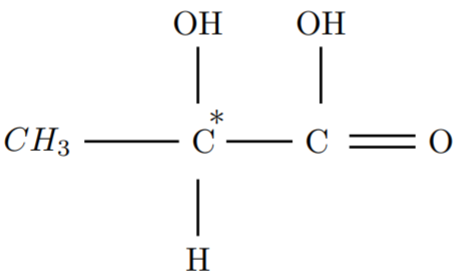
What are chiral carbons \[?\]
Answer
490.2k+ views
Hint: First we know that chiral molecules are the molecules which are non superimposable on their mirror images and these properties are known as chirality. Chiral carbon atoms are also referred to as stereogenic carbons or asymmetrical carbon atoms.
Complete answer:
The chiral carbon atoms are carbon atoms that are attached to four different atoms or groups of atoms losses all symmetry, that are placed at the corners of a tetrahedron. The configuration of such a tetrahedral unit is chiral. The structure may exist in either a right-handed configuration or a left-handed configuration. This type of configurational stereoisomers is termed enantiomorphism.
Example: consider a lactic acid

Here the carbon which is indicated by \[*\] The sign is chiral carbon.
The four groups of atoms attached to the carbon atom can be arranged in space in two different ways that are like mirror images of each other.
Note:
The Bel-van't Hoff rule states that the number of stereoisomers of an organic compound is \[{2^n}\], where \[n\] is the number of chiral carbon atoms (unless there is an internal plane of symmetry). Hence if \[n\] is the number of chiral carbon atoms then the maximum number of isomers is \[{2^n}\].
Complete answer:
The chiral carbon atoms are carbon atoms that are attached to four different atoms or groups of atoms losses all symmetry, that are placed at the corners of a tetrahedron. The configuration of such a tetrahedral unit is chiral. The structure may exist in either a right-handed configuration or a left-handed configuration. This type of configurational stereoisomers is termed enantiomorphism.
Example: consider a lactic acid

Here the carbon which is indicated by \[*\] The sign is chiral carbon.
The four groups of atoms attached to the carbon atom can be arranged in space in two different ways that are like mirror images of each other.
Note:
The Bel-van't Hoff rule states that the number of stereoisomers of an organic compound is \[{2^n}\], where \[n\] is the number of chiral carbon atoms (unless there is an internal plane of symmetry). Hence if \[n\] is the number of chiral carbon atoms then the maximum number of isomers is \[{2^n}\].
Recently Updated Pages
Master Class 12 Business Studies: Engaging Questions & Answers for Success

Master Class 12 Economics: Engaging Questions & Answers for Success

Master Class 12 English: Engaging Questions & Answers for Success

Master Class 12 Maths: Engaging Questions & Answers for Success

Master Class 12 Social Science: Engaging Questions & Answers for Success

Master Class 12 Chemistry: Engaging Questions & Answers for Success

Trending doubts
What are the major means of transport Explain each class 12 social science CBSE

Which are the Top 10 Largest Countries of the World?

Draw a labelled sketch of the human eye class 12 physics CBSE

Explain sex determination in humans with line diag class 12 biology CBSE

The pH of the pancreatic juice is A 64 B 86 C 120 D class 12 biology CBSE

Give 10 examples of unisexual and bisexual flowers




